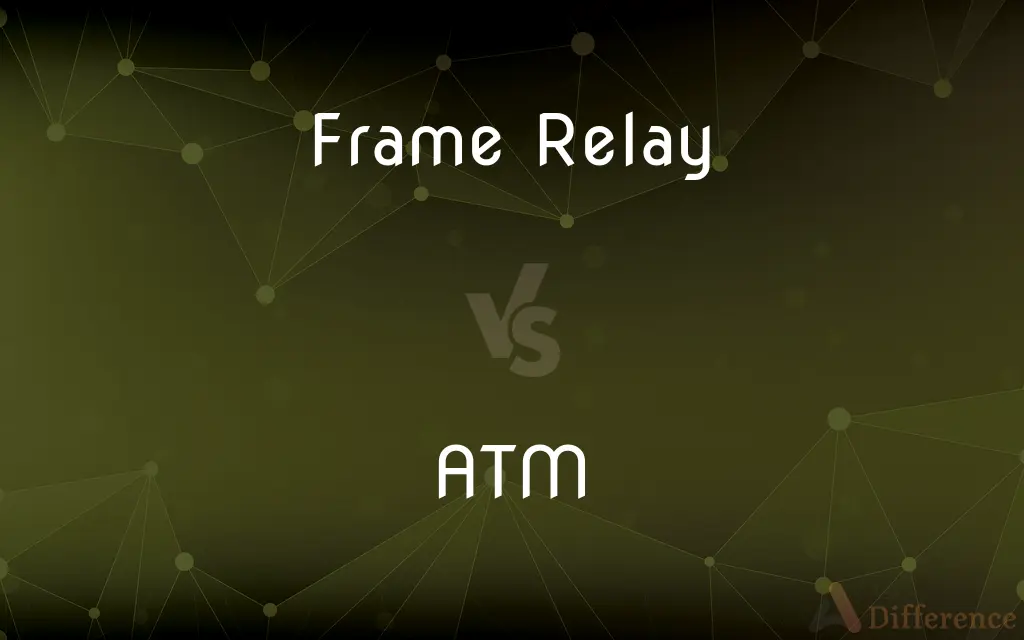Frame Relay vs. ATM — What's the Difference?
By Tayyaba Rehman & Urooj Arif — Published on February 2, 2024
Frame Relay is a packet-switched WAN protocol that handles variable-sized frames, efficient for bursty data. ATM (Asynchronous Transfer Mode) is a cell-switched networking protocol using fixed-size cells, ideal for constant data rates.

Difference Between Frame Relay and ATM
Table of Contents
ADVERTISEMENT
Key Differences
Frame Relay is a WAN protocol designed for cost-effective data transmission for intermittent traffic between local area networks (LANs) and between end-points in a wide area network (WAN). ATM, short for Asynchronous Transfer Mode, is a telecommunications standard designed for the transmission of audio, video, and data over a network, prioritizing consistent data flow.
In Frame Relay, data is sent in variable-sized units called frames, making it suitable for data that can tolerate some delay in transmission such as email and file transfers. In contrast, ATM transmits data in fixed-size cells, which are efficient for carrying voice and video traffic where consistent delivery timing is critical.
Frame Relay is known for its simplicity and efficiency in handling bursty data traffic, which makes it less expensive and easier to implement and manage. ATM is designed to minimize latency and maintain a constant transmission rate, making it more suitable for real-time applications but also more complex and costly.
The network architecture of Frame Relay is typically used for connecting LANs over a WAN, offering an effective solution for businesses with distributed offices. ATM, with its ability to handle multiple types of traffic simultaneously, is often employed in backbone networks and for broadband ISDN.
Frame Relay allows for flexible bandwidth and can dynamically adjust to the traffic flow, offering a cost-effective solution for many businesses. ATM, with its stringent quality of service (QoS) guarantees, is ideal for applications requiring rigorous timing and bandwidth guarantees, like video conferencing.
ADVERTISEMENT
Comparison Chart
Data Transmission Unit
Variable-sized frames
Fixed-size cells
Suitability
Intermittent, bursty traffic
Constant, real-time traffic
Complexity and Cost
Less complex, more cost-effective
More complex, higher cost
Typical Use Cases
Connecting LANs over WAN
Backbone networks, broadband ISDN
Bandwidth Management
Flexible, adjusts to traffic
Fixed, with QoS guarantees
Compare with Definitions
Frame Relay
Frame Relay provides a cost-effective way to transmit data over a WAN.
By implementing Frame Relay, the organization reduced its network operation costs.
ATM
ATM is a network protocol that transmits data in fixed-size cells.
The telecom company used ATM for its ability to handle voice, video, and data traffic simultaneously.
Frame Relay
Frame Relay is a networking protocol that handles data in variable-sized frames.
Frame Relay was chosen for its ability to handle the sporadic data traffic from the remote sensors.
ATM
ATM maintains a constant transmission rate, minimizing latency.
The emergency services deployed an ATM network for reliable and timely communication.
Frame Relay
Frame Relay dynamically adjusts bandwidth based on traffic flow.
Frame Relay's bandwidth flexibility was essential for the fluctuating demands of the network.
ATM
ATM is known for its stringent quality of service guarantees.
The bank's video conferencing system relied on ATM for uninterrupted, high-quality connections.
Frame Relay
Frame Relay is suited for data that can tolerate delays, like emails and file transfers.
The IT department relied on Frame Relay for daily backups and email traffic across the network.
ATM
ATM is a cell-switched networking protocol ideal for voice and video transmission.
The university's distance learning program utilized ATM technology to deliver lectures in real-time.
Frame Relay
Frame Relay is a packet-switched WAN protocol for connecting devices on a network.
The company used Frame Relay to efficiently connect its various branches.
ATM
ATM supports multiple types of traffic, offering consistent delivery for real-time applications.
ATM was critical in maintaining the quality of the live broadcast over the network.
ATM
An unattended electronic machine in a public place, connected to a data system and related equipment and activated by a bank customer to obtain cash withdrawals and other banking services.
ATM
A unit of pressure: the pressure that will support a column of mercury 760 mm high at sea level and 0 degrees centigrade
ATM
A means of digital communications that is capable of very high speeds; suitable for transmission of images or voice or video as well as data;
ATM is used for both LAN and WAN
ATM
An unattended machine (outside some banks) that dispenses money when a personal coded card is used
Common Curiosities
How does Frame Relay handle data?
Frame Relay transmits data in variable-sized frames, suitable for bursty traffic.
What is ATM?
ATM (Asynchronous Transfer Mode) is a networking protocol using fixed-size cells for data transmission.
What is the cell size in ATM?
ATM uses fixed-size cells of 53 bytes for data transmission.
Can Frame Relay be used for real-time applications?
Frame Relay is less ideal for real-time applications due to its variable frame size.
Is ATM suitable for voice and video transmission?
Yes, ATM is well-suited for voice and video due to its consistent cell size and transmission rate.
What is Frame Relay?
Frame Relay is a WAN protocol that uses variable-sized frames for efficient data transmission.
Does ATM offer quality of service guarantees?
Yes, ATM provides stringent QoS guarantees for various types of traffic.
Where is ATM most commonly used?
ATM is often used in backbone networks and for broadband ISDN.
What kind of network is typically built with Frame Relay?
Frame Relay is commonly used for connecting LANs over a WAN.
How does Frame Relay handle network congestion?
Frame Relay uses congestion notification mechanisms but does not guarantee delivery.
What are the main benefits of ATM?
ATM offers consistent data transmission rates and supports multiple traffic types.
Is Frame Relay still widely used?
Frame Relay usage has declined with the advent of more modern technologies.
Is ATM more expensive than Frame Relay?
Generally, ATM is more complex and costly compared to Frame Relay.
What are typical applications of ATM?
ATM is used in applications requiring high-quality voice, video, and data transmission.
Can Frame Relay adjust to traffic flow?
Yes, Frame Relay can dynamically adjust bandwidth based on traffic flow.
Share Your Discovery

Previous Comparison
Mustard Oil vs. Vegetable Oil
Next Comparison
Reward vs. PrizeAuthor Spotlight
Written by
Tayyaba RehmanTayyaba Rehman is a distinguished writer, currently serving as a primary contributor to askdifference.com. As a researcher in semantics and etymology, Tayyaba's passion for the complexity of languages and their distinctions has found a perfect home on the platform. Tayyaba delves into the intricacies of language, distinguishing between commonly confused words and phrases, thereby providing clarity for readers worldwide.
Co-written by
Urooj ArifUrooj is a skilled content writer at Ask Difference, known for her exceptional ability to simplify complex topics into engaging and informative content. With a passion for research and a flair for clear, concise writing, she consistently delivers articles that resonate with our diverse audience.
















































